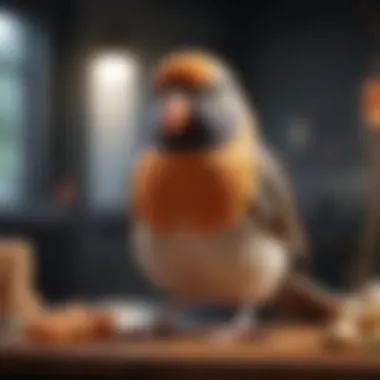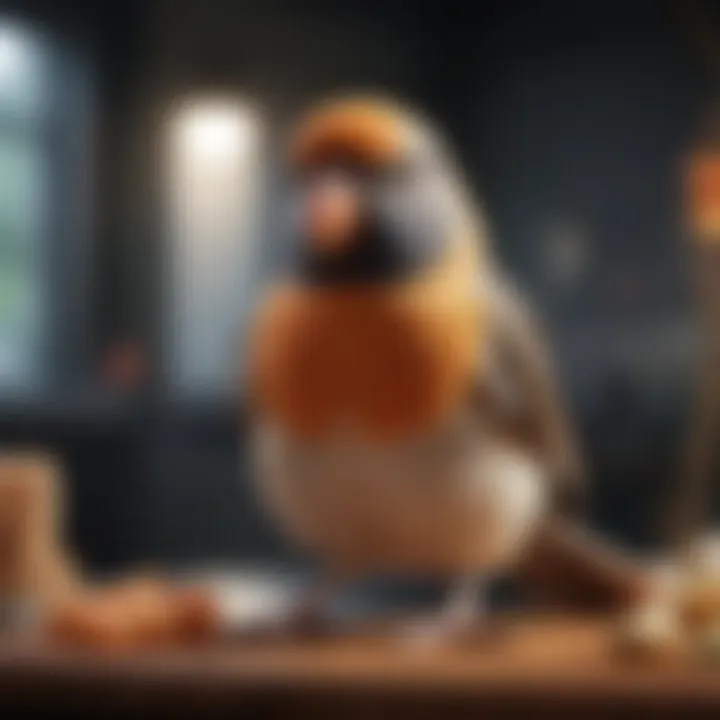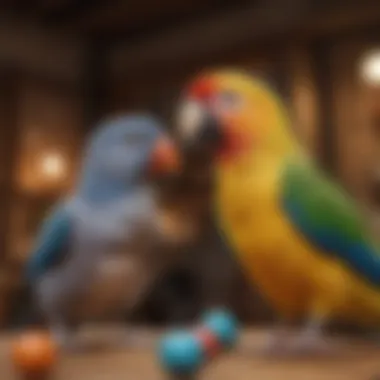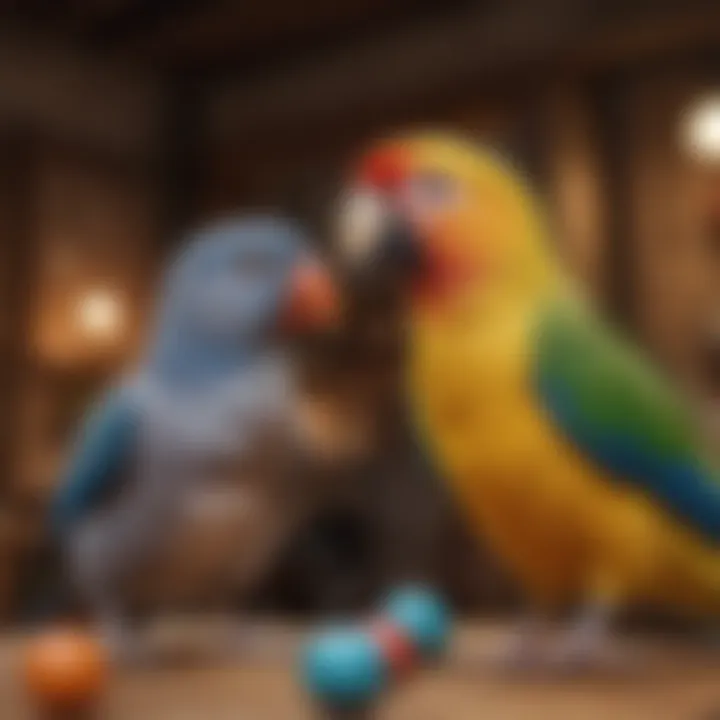Caring for Two Pet Birds: A Complete Guide


Intro
Caring for two pet birds presents unique challenges and rewards. These creatures, with their vibrant colors and distinct personalities, can thrive in a home where they receive the right care and attention. As a potential bird owner or someone with experience in aviculture, understanding the nuances of bird care is essential. This comprehensive guide will examine practical advice on caring for two pet birds, illustrating their interdependence and the mutual benefits of companionship among them.
Birds are social animals, and many species flourish when they are kept in pairs. With this comes the necessity to ensure that both birds have proper compatibility, a conducive environment, a suitable diet, and engaging activities. This guide aims to cover these aspects by providing detailed insights and practical tips to enhance the overall well-being of your feathered companions.
Care Tips
Daily Care Routines
Establishing a consistent daily care routine for your birds is vital for their well-being. This includes feeding, cleaning their living space, and ensuring adequate interaction time. Most birds enjoy a structured schedule, which can help reduce stress. It's wise to feed them at the same time each day and ensure fresh water is always available.
Cage Setup and Maintenance
Creating an optimal living environment for your birds means ensuring their cages are appropriately sized and outfitted. The cage should be spacious enough to allow for wing flapping and movement. Use perches of varying widths and materials to promote foot health. Regular maintenance involves cleaning every part of the cage, including the food and water dishes.
Hygiene and Cleaning Practices
Maintaining cleanliness is crucial in preventing illnesses. Daily spot cleaning should be routine, focusing on droppings and leftover food. Weekly, perform a deeper clean, using bird-safe disinfectants. The health of your birds largely depends on the cleanliness of their environment.
Seasonal Care Adjustments
Birds may require different care based on the seasons. In winter, ensure they have adequate warmth, possibly using a heater for their room. In summer, be wary of overheating. Provide shade and sufficient hydration to keep them comfortable.
Behavioral Insights
Understanding Bird Body Language
Birds communicate through subtle body language. Recognizing signs of happiness, stress, or discomfort can be a game-changer. Indicators such as puffed-up feathers, vocalizations, and wing positioning can provide insights into their emotional states.
Common Behavioral Issues and Solutions
Common issues like excessive screeching or aggressive behavior can arise in pet birds. It is essential to identify triggers such as boredom or environmental disturbances. Finding appropriate outlets, like toys or additional social interaction, can alleviate these problems.
Positive Reinforcement Techniques
Training birds to perform basic commands or tricks can be rewarding. Positive reinforcement through treats or praise encourages desired behaviors. Consistency and patience in this technique yield the best results.
Social Interaction Needs
Both birds need ample social interaction, not just with their owners but with each other. Observing their interactions allows for understanding their preferences and fostering positive relationships.
Nutrition Guides
Essential Diet Components
A balanced diet for pet birds includes high-quality pellets, fresh vegetables, and fruits. Each species may have distinct dietary needs. Ensure the diet supports their health and mimics their natural feeding habits as closely as possible.
Safe and Toxic Foods
It is vital to know which foods are safe and which are toxic. For instance, avocados and chocolate are harmful to birds. Always research before introducing new foods.
Supplements and Treats
Consider safe supplements and treats to enhance their diet. These can provide necessary vitamins and minerals that may be lacking in their daily intake.
Feeding Strategies for Different Species
Understanding species-specific dietary requirements is critical. For example, budgerigars require different nutrition than cockatiels. Tailoring meals can help in maintaining health.
Wellness and Health
Routine Health Checkups
Schedule regular health checkups with an avian veterinarian. Catching health issues early can mitigate more serious problems later.
Identifying Symptoms of Illness
Be vigilant for signs of discomfort in your birds, such as changes in eating habits, excessive preening, or peculiar vocalizations. Knowing when to seek professional help is paramount.
Preventative Care and Vaccinations
Vaccinations may be necessary depending on your location and the species of your birds. Discuss potential vaccine protocols with your vet.
Mental and Emotional Well-being
Birds require not only physical health but emotional stimulation. Providing a variety of toys and social interaction contributes to their overall happiness.
Enriching Activities
Toys and Playtime Ideas
Introduce a range of stimulating toys that promote physical and mental engagement. Rotate them frequently to maintain interest.
Training and Tricks
Training for simple tricks can provide mental stimulation for your birds. Use patience and rewards to encourage progress and strengthen your bond.
Outdoor Activities and Interaction
Supervised outdoor activities can offer fresh experiences. Ensure safety to prevent escapes or exposure to predators.
DIY Projects for Mental Stimulation
Create homemade toys or puzzles from safe materials. Engaging your birds in crafting their environmental enhancements keeps them entertained.
Bird care demands a thorough understanding of their psychological and physical needs. By delving into these topics, owners can significantly enhance the lives of their feathered friends.
Prolusion to Keeping Two Pet Birds
Caring for two pet birds requires understanding their unique needs and dynamics. This section serves as a foundation for bird owners and those considering to become pet parents. Addressing the importance of cohabitation, it will explore aspects like species compatibility, interaction, and the benefits of having more than one bird.
The Popularity of Avian Companions


Birds have become increasingly popular pets. Their vibrant colors and wide range of species appeal to many. Some people find them to be lower maintenance compared to cats or dogs. Furthermore, their lively personality and intelligence often attract bird enthusiasts. Social media platforms have even highlighted birds’ playful behaviors, further fueling their popularity.
Benefits of Having Two Birds
Social Interaction
Social interaction between two birds is vital. Birds are social creatures that thrive when they have companionship. Having a partner can reduce loneliness. This can lead to improved mental and emotional well-being for both pets. They interact through various vocalizations and body language, creating a stimulating environment. Birds that spend time together often display healthier habits, making this arrangement beneficial.
Enrichment Opportunities
Enrichment opportunities are abundant when keeping two birds together. They can engage in play and exploration with one another. This mutual interaction promotes cognitive development. Providing various toys and activities helps keep them active. Moreover, focusing on these enrichment activities can lead to decreased boredom and encourage natural behaviors. This supports a more fulfilling life for your birds.
Behavioral Learning
Behavioral learning is another advantage of keeping two birds. Observing one another can teach essential social skills. This learning process can reduce aggressive behavior, as they model positive interactions. Additionally, one bird may learn new tricks more quickly by watching the other. This enhances their bond and makes training easier. Overall, two birds often create a more enriching environment than a single pet.
Choosing the Right Species
Choosing the right species is a crucial element in ensuring a harmonious and fulfilling life for pet birds. This decision has implications for potential interactions and overall well-being of the birds. Key factors include compatibility and the specific needs of each species. Selecting compatible birds can significantly enhance their socialization, reducing the chances of conflict and stress.
Evaluating Compatibility
Temperament Differences
Understanding temperament differences among species is essential. Some birds are naturally more social and outgoing, while others may exhibit shyness or aggression. The key characteristic of social birds, like parakeets, is their tendency to seek companionship. This trait makes them suitable for cohabitation, as they thrive when they have another bird for interaction. However, an overly aggressive bird may intimidate the more timid one, leading to stress. Assessing these characteristics before introduction is beneficial, as it encourages smoother interactions and reduces potential conflicts.
Size Considerations
Size is another important factor when pairing birds. The key characteristic here is proportionality in size and strength. For example, a larger bird may inadvertently harm a smaller one during play or feeding. Thus, it is wise to choose species that are similar in size. This consideration not only promotes safety but also aids interaction. Larger birds may become frustrated or bored if they have to accommodate smaller companions during games or flight. Balancing size helps in creating a more peaceful cohabitation experience, leading to a more pleasant environment.
Popular Species for Cohabitation
Parakeets
Parakeets are often recommended for those considering two birds. Their friendly nature and adaptability make them a popular choice in avian communities. They communicate easily with each other, lessening the chances of loneliness. Their ability to engage in synchronized activities adds a layer of entertainment for owners. However, they do require consistent social interaction; without it, they may develop behavioral issues.
Cockatiels
Cockatiels are noted for their affectionate disposition. They are often described as gentle and can form strong bonds with their human caregivers as well as with each other. Their vocalizations and ability to mimic sounds contribute positively to their interactions. However, they may need more time to adjust if prominently displaying territorial behavior. Therefore, early socialization and gradual introductions are vital.
Lovebirds
Lovebirds are unique in their bonding behavior. They tend to form strong pair bonds, sometimes leading to exclusive attachments. Their affectionate nature makes them delightful companions. They flourish when provided with ample room for interaction and play. However, it is crucial to supervise them frequently during the first interactions to prevent any dominance disputes. Misalignment in energy levels can be a challenge if one bird is particularly energetic.
"The choice of species lies at the heart of successful avian companionship. Understanding their unique behavioral traits can greatly enhance your experience."
Creating an Optimal Living Space
Creating an optimal living space for pet birds is crucial for their well-being and happiness. Birds are social creatures and need an environment that supports their natural behaviors. A well-designed living space includes adequate cage size, proper setup, and suitable enriching environments. This ensures that the birds can thrive, play, and interact, both with each other and their surroundings.
Cage Size and Setup
Space Requirements
Cage size is perhaps the most significant factor to consider. Each species of bird has its own space requirements based on size and activity level. Parakeets, for example, need a cage that is at least 24 inches long, while larger species like cockatiels require more room. A spacious cage allows birds to stretch their wings and engage in natural movements like climbing and flying.
A larger cage can also reduce stress. Birds often engage in territorial behaviors, and having enough room can help mitigate conflicts. An overcrowded cage may lead to aggressive behaviors, impacting both birds negatively. It is wise to prioritize space requirements when planning the housing for two pet birds.
Essential Accessories
Apart from cage size, essential accessories are vital in creating an optimal living space. Accessories include perches, food and water dishes, and toys. The quality and variety of these items contribute to a satisfying environment for the birds. For instance, diverse perches of different sizes and materials can help keep their feet healthy.
Additional accessories like foraging toys encourage mental stimulation and reduce boredom. Without these elements, birds may become listless or develop undesirable behaviors. Quality accessories create a comfortable and engaging habitat for your avian friends.
Environmental Enrichment Strategies
Toys and Activities
Introducing engaging toys and activities is fundamental to enriching the lives of pet birds. Toys that encourage foraging, manipulating, or chewing can keep birds busy. They stimulate both their physical and mental abilities, preventing behavioral issues that may arise from boredom.
Different types of toys cater to various species. For example, lovebirds often enjoy interactive toys that involve partnership play. It is vital to rotate toys regularly to maintain interest and engagement. Offering a variety of toys is not just beneficial but essential in keeping your birds stimulated.
Safe and Stimulating Habitat
Creating a safe and stimulating habitat extends beyond the cage itself. Birds should have access to safe areas for out-of-cage time. This allows them to explore and socialize, creating a richer experience. Safe homes should be free from hazards like toxic plants, sharp objects, and open windows.
Establishing an environment that promotes exploration encourages natural behaviors. Gradually introducing new elements will pique their curiosity. A stimulating habitat supports overall well-being by catering to their instinctual needs and diversifying their experiences.
"A fulfilling living space for pet birds not only meets their physical needs but also allows for an enriched social environment that is essential for their development."
In summary, creating an optimal living space involves careful consideration of cage size, essential accessories, and engaging environmental enrichment. Each element plays a significant role in ensuring the happiness and well-being of two pet birds.
Nutrition for Two Birds
Nutrition is a critical component in the care of two pet birds. A well-balanced diet not only supports the birds' physical health but also influences their behavior, interactions, and overall wellbeing. Given that birds may have different nutritional needs based on their species, age, and activity levels, understanding the right dietary elements can prevent conflicts and promote harmony in a shared environment.
Balanced Diet Essentials
Seeds, Pellets, and Fresh Produce
Seeds, pellets, and fresh produce form the foundation of a balanced diet for pet birds. Seeds are often favored for their taste, but they can be high in fat, leading to health issues if consumed exclusively. Pellets, designed to provide a complete nutrient profile, offer more nutritional variety. Fresh produce supplements these diets, offering vitamins and minerals essential for maintaining health.
Some important factors to consider include:
- Nutritional Balance: Pellets are usually more nutritionally balanced compared to seeds.
- Variety: Fresh produce adds valuable nutrients and can encourage natural foraging behavior.
- Limitation of Seeds: Too many seeds can lead to obesity and other health problems.
Advantages include the convenience of pellets and the freshness of vegetables, which can encourage birds to sample a wider variety of foods. Disadvantages involve the need for gradual introduction of new foods, as some birds may resist change in diet.
Nutritional Supplements
Nutritional supplements can play a vital role in the diets of pet birds, especially for species with specific dietary requirements. These supplements can include vitamins, minerals, and amino acids, which may not be sufficiently present in standard diets. They can help in preventing deficiencies and support overall health.
Noteworthy points about nutritional supplements:


- Targeted Nutrition: Supplements can be tailored to specific dietary needs, such as calcium for females during breeding.
- Enhancement: They can improve the overall nutrient profile of a pet bird’s diet.
- Potential Overreliance: There is a risk of over-supplementation, leading to health complications.
By carefully incorporating nutritional supplements into their diet, bird owners can enhance the health of their feathered friends while ensuring they meet their specific needs.
Feeding Strategies to Promote Harmony
Food Placement Techniques
The way food is presented can greatly influence interactions between two birds. Placing food in multiple locations can encourage cooperative feeding and reduce territorial disputes. Each bird should have access to their share of food without competition. This method can improve their relationship and ensure that both birds receive adequate nutrition.
Considerations for food placement include:
- Accessibility: Food should be placed in areas accessible to both birds.
- Multiple Stations: Distributing food in various spots can mitigate aggressive behaviors.
- Observation: Monitoring eating habits can help identify any issues in sharing food.
Encouraging Cooperation
Promoting cooperation during feeding is essential for a peaceful environment. One method is to establish feeding routines, where birds are fed at the same time, fostering a sense of community during mealtimes. This routine can be adjusted based on their behavior and preferences.
Key elements to encourage cooperation include:
- Routine: Establishing a consistent feeding schedule can build trust.
- Positive Interactions: Monitoring cooperative feeding can boost bonding.
- Training: Using training techniques to reward peaceful co-feeding can also be effective.
By applying strategic feeding methods, owners can foster a harmonious atmosphere between their birds, which is beneficial for both their health and their relationship.
"Optimal nutrition not only sustains the health of your pet birds but also fosters a peaceful living environment, reducing potential conflicts."
Health and Wellness Considerations
Maintaining the health and wellness of pet birds is crucial for their longevity and overall quality of life. Birds can be susceptible to various health issues, often arising from environmental stressors, poor diet, or lack of social interaction. Therefore, understanding health considerations is fundamental for bird owners. Two pet birds can benefit especially from shared interactions that promote psychological and emotional well-being. It is essential to prioritize both physical and mental health through regular vet visits, proper care, and routine monitoring of their behavior.
Regular Veterinary Checkups
Choosing an Avian Vet
Choosing an avian veterinarian is a significant step in ensuring your birds receive proper medical attention. Not all vets have the training or experience needed to care for birds specifically. An avian vet specializes in the treatment of pet birds, offering insights and care tailored to their unique physiology.
An important characteristic of avian vets is their understanding of the specific needs of different bird species. This focus makes them a popular choice among pet bird owners. They are knowledgeable about species-specific diseases, nutritional needs, and behavioral concerns. An avian vet’s unique feature is their access to specialized equipment designed for birds, allowing for more accurate diagnoses compared to general practitioners. However, finding such a vet may require additional effort if you live in a less populated area.
Preventive Care
Preventive care is a proactive approach to maintaining your birds' health. It consists of routine exams, vaccinations, and guidance on nutrition and housing. This approach helps in early detection of potential health problems, such as respiratory issues, nutritional deficiencies, or behavioral disorders.
Preventive care is defined through its ability to improve the quality of life for your pets. Regular checkups can identify health concerns before they escalate. A unique feature of preventive care is that it often includes recommendations for environmental improvements to reduce stress and enhance overall well-being. However, some owners may underestimate the importance of regular checkups, thinking their birds appear healthy without recognizing unseen ailments.
Recognizing Illness Symptoms
Behavioral Changes
Behavioral changes in pet birds can signal underlying health issues. Birds that are usually active and vocal may become withdrawn or lethargic, indicating discomfort or illness. Observing these changes is key to early diagnosis and treatment.
The key characteristic of monitoring behavioral changes is that it requires careful observation over time. Documentation of these changes can help veterinarians make more accurate assessments. Being aware of even small variances in behavior could lead to quicker intervention, which is beneficial for both the birds and their caretakers. Birds are good at hiding illness, so subtle cues can be vital in detecting potentially serious problems before they worsen.
Physical Indicators
Physical indicators are visible signs that can reveal a bird’s health status. These might include changes in feather appearance, alterations in eating habits, or abnormal droppings. Recognizing these signs is essential in promoting health awareness among pet owners.
One important aspect of physical indicators is that they provide clear evidence of a bird's well-being. Regularly inspecting your birds can alert you to any issues early on. A unique feature of physical indicators is that they can serve as direct points of communication between the bird and the owner. Owners who are diligent in checking their birds for signs of distress or illness are more likely to maintain a healthy environment for them. Lack of awareness regarding these indicators can result in delayed treatment and exacerbate health problems.
Keeping your birds healthy requires vigilance and commitment. It is always better to act cautiously when it comes to your feathered companions' well-being.
Behavioral Observations
Understanding behavioral observations is vital when caring for two pet birds. Birds are inherently social creatures. Observing their behavior gives insights into their emotional state and interactions with each other. Behavioral patterns can indicate if they are content, stressed, or facing issues. Through proper observation, you can enhance their living experience significantly, ensuring they are mentally and emotionally stimulated.
Understanding Communication
Vocalizations
Vocalizations are an essential part of how birds communicate. They use sounds to express needs, emotions, and social bonding. Different vocalizations can represent specific meanings, such as alarm calls or mating calls. Key characteristics of vocalizations include frequency, tone, and pattern. These aspects are crucial for identifying what your birds may be feeling or needing at any moment. For instance, a loud, consistent squawking can indicate distress or boredom.
A unique feature of vocalizations is that they can also serve educational purposes. Training your birds to respond to specific calls can create a routine that supports interaction. However, excessive noise can become overwhelming. It's important to find the balance between encouraging vocal expression and maintaining a peaceful environment.
Body Language
Birds express themselves significantly through body language. This includes postures, wing positions, and even feather movements. Understanding these signals is crucial in fostering a safe and healthy environment for your birds. A key characteristic of body language is that it often conveys emotions more clearly than vocalizations. For example, puffed-up feathers may denote aggression, while relaxed feathers indicate comfort.
A distinct advantage of knowing body language is that it can prevent conflicts between your birds. Recognizing signs of unease can prompt preemptive measures before a skirmish develops. However, misinterpretation of body signals poses a disadvantage, leading to incorrect assumptions about a bird's emotional state.
Conflict Resolution Techniques
Identifying Triggers
Identifying triggers is key in managing conflicts between your birds. Different factors can provoke aggressive or anxious behavior, such as changes in the environment or introduction of new toys. Recognizing these triggers enables you to anticipate and mitigate potential conflicts. A key characteristic of this approach is its proactive nature. By understanding what causes distress, you can create a stable environment for your birds.
A unique feature of identifying triggers lies in its adaptability. Each bird has its own unique set of triggers based on previous experiences. This personal approach allows bird owners to tailor their care effectively. On the downside, this method can be time-consuming. It requires patience and effort to observe and document these behaviors consistently.
Mediation Strategies
Mediation strategies play an essential role in ensuring peaceful cohabitation among your birds. Techniques such as distraction or separation can often diminish tensions during conflicts. A critical aspect of mediation strategies is the emphasis on intervention before issues escalate. Quick and thoughtful responses can prevent injuries.
The unique aspect of these strategies is their reliance on understanding both birds' behaviors. This dual focus can promote long-term harmony. Nevertheless, relying solely on mediation without considering the root causes may lead to repeated conflicts.
"Effective behavioral observations lead to happier, healthier pet birds." Using these strategies and understandings creates a harmonious environment, ensuring both birds thrive.
Socialization and Interaction
Socialization and interaction are essential components for the well-being of pet birds. They can greatly enhance the quality of life for both birds involved. Interacting with one another fosters strong social bonds and contributes to their emotional health. Birds are social creatures by nature, and when kept together, they can engage in behaviors that mimic their wild counterparts. This section will cover how to encourage play and bonding, and strategies for building trust while reducing aggression between two pet birds.
Encouraging Play and Bonding
Shared Activities
Shared activities are vital for encouraging bonding between two pet birds. Engaging in play together can help strengthen their relationship. It allows them to develop social skills and can even prevent feelings of loneliness. One of the key characteristics of shared activities is that they promote cooperative behavior. When two birds play together, it often leads to a healthier social dynamic. Such activities might include playing with toys, chasing each other, or even bathing together.


The unique feature of shared activities is the opportunity for both birds to communicate and build trust. However, it is important to monitor their interactions. Not all birds may be inclined to share. Conflict can arise if one bird is overly possessive of toys. Positive reinforcement during play can mitigate this issue, making shared activities a beneficial and crucial aspect of their interaction.
Individual Attention
Providing individual attention to each bird is another important strategy that compliments shared play. Each bird has its own personality and preferences, and recognizing these individual traits can improve their overall happiness. Individual attention allows aviary owners to bond with each bird separately, which can reinforce their understanding of both birds’ behaviors.
The key characteristic of individual attention lies in the one-on-one connection it establishes. A bird receiving individual care may be more confident, which can prevent jealousy during group interaction. This method is not only beneficial; it is equally important for balanced emotional development. A potential disadvantage is the time commitment required. Owners should strive to find a balance between shared and individual interactions to sustain harmony in the household.
Building Trust and Reducing Aggression
Training Techniques
Incorporating training techniques can significantly enhance trust between two pet birds. Training can include basic commands or tricks that both birds learn together. The positive reinforcement associated with training encourages birds to engage willingly. This successful engagement builds trust and strengthens their relationship with the owner, too.
A key characteristic of training techniques is consistency. Maintaining a routine and using the same commands will help birds understand expectations better. This consistency is critical in developing a strong sense of security in their environment. Using training techniques has the potential disadvantage of requiring patience and time to see results, but in the long run, it can lead to a more harmonious household.
Positive Reinforcement
Positive reinforcement is a widely accepted approach for encouraging desirable behaviors in birds. This method involves rewarding birds for showing specific behaviors. For example, giving a treat when they play nicely together can reinforce that behavior.
The significant characteristic of positive reinforcement is its ability to create a positive atmosphere for learning. When birds associate good behavior with rewards, they are more likely to repeat it. This method not only helps reduce aggression but also fosters trust between the birds and their owner. However, it's crucial to ensure that the treats provided do not lead to overfeeding. This balance makes positive reinforcement an effective choice in nurturing a peaceful coexistence between pet birds.
Key Takeaway: Proper socialization and interaction strategies can greatly enhance the relationship between pet birds, leading to a happier and healthier environment.
Traveling with Two Birds
Traveling with two pet birds requires careful planning to ensure their comfort and safety. Birds can be sensitive to changes in their environment. They may experience stress during travel, making it crucial to prepare thoroughly. Understanding how to manage travel well can enhance the overall experience for both the birds and the owner. This section will highlight essential preparations and considerations for doing so.
Preparing for Travel
Transport Options
Choosing the right transport option is critical. Options include sturdy bird carriers or travel cages that are well-ventilated. A good carrier must allow for sufficient airflow and prevent escape. Carriers designed specifically for birds are a beneficial choice because they often have features such as secure locking mechanisms. These carriers often provide comfort during transport, allowing birds to feel more secure. Using a travel cage can keep birds safe from sudden jolts during a car ride. The unique feature of a travel cage is that it often comes with attachment points for toys. This is helpful to keep the birds entertained during the travel period.
While some owners might consider a small pet travel crate as a cheaper alternative, it may lack adequate ventilation or safety features. This might result in stress, making a proper bird carrier a better choice overall.
Safety Precautions
Implementing safety precautions is essential for a successful trip. One key characteristic is ensuring the travel carrier is stable and easy to handle. A well-secured carrier keeps birds from moving or falling during travel. It is important to avoid sudden movements, which could injure the birds. Adding bedding material such as towel or newspaper can also prevent slipping. This ensures birds have a comfortable place for sitting.
Be aware of temperature extremes. Keeping the car at a moderate temperature is crucial for safety. If needed, use a portable heater or air conditioning to avoid drastic temperature changes inside the carrier.
While some birds might adapt well to travel, others may need more guidance. Make sure to never leave the birds unattended in the car, especially during warm weather.
Adjusting to New Environments
Managing Stress Levels
Managing stress levels for birds during trips is vital. Birds can pick up on the owner's anxiety, affecting their own comfort. A calm demeanor can encourage a soothing environment. Before embarking on the journey, familiarize the birds with their carrier. Allow them to explore it at home to reduce anxiety when travel begins.
Using calming techniques like covering the carrier with a light cloth can provide comfort. This method mimics their natural instinct to hide when feeling threatened. Ensuring a safe environment helps in reducing stress responses and makes the journey smoother.
Establishing Routine
Having a routine during travel can significantly help the birds adjust. Birds thrive on consistency, and a well-planned schedule assures them that everything is under control. Regular feeding times and scheduled breaks are beneficial strategies to maintain their comfort. It is good to stop periodically during long trips to allow the birds to stretch their legs.
Also, try to maintain their regular schedule for important activities such as feeding. Sudden changes to their routine can cause confusion and distress. Keeping their routine stable in new environments helps in providing a sense of security during travel.
"Travel requires careful considerations for the well-being of the birds. Successful travel happens through proper prep and routine."
Creating Enrichment Activities
Creating enrichment activities is vital for any bird owner who aims to provide a fulfilling life for their feathered companions. Enrichment activities can enhance physical health and stimulate mental engagement. The main purpose is to prevent boredom and encourage natural behaviors. When two birds are together, these activities also promote social interaction. A well-planned enrichment routine can lead to happier and healthier birds, ensuring they thrive in your care.
Physical Enrichment Ideas
Play Structures
Play structures serve as essential tools for physical enrichment. They offer birds a designated area for climbing, swinging, and exploring. This aspect contributes significantly to the overall goal of keeping birds active and preventing obesity. A key characteristic of play structures is variety; they often come in different shapes and sizes, catering to the specific needs of various bird species. Their popularity among pet bird owners is due to their ability to provide endless hours of entertainment.
A unique feature of play structures is the use of natural materials like wood. Having something that mimics a bird's natural environment makes playtime more engaging. However, there are disadvantages, such as the need for regular cleaning and potential wear over time. Investing in high-quality play structures can mitigate these issues, ensuring safe and enjoyable play for your birds.
Foraging Opportunities
Foraging opportunities are another essential component of enrichment activities. They encourage birds to engage in their natural instinct to search for food. This activity not only provides stimulation but also combats boredom. The key characteristic of foraging is diversity; it includes hiding food in different locations or using foraging toys designed specifically for this purpose.
These opportunities are beneficial because they enhance problem-solving skills and promote physical activity. A unique benefit of foraging activities is that they can be easily tailored to match the preferences of individual birds. That said, some birds may take longer to discover food items, leading to frustration. Careful observation can help owners adjust methods to suit their birds' needs better.
Mental Stimulation Techniques
Puzzle Toys
Puzzle toys are excellent tools designed to engage birds mentally. They require birds to think critically to access treats hidden inside. This aspect of puzzle toys makes them attractive to bird owners who want to foster cognitive development. A significant characteristic of these toys is their complexity; they come in various designs that challenge birds to solve different problems.
These toys are beneficial because they stimulate both the mind and body. Birds become more active as they work through the challenges. However, owners must select puzzles that match their birds’ skill levels to avoid frustration or discouragement. With the right puzzle toy, mental stimulation can become a regular part of your bird's routine.
Training Challenges
Training challenges provide another dimension of mental stimulation. They involve teaching birds specific tricks or behaviors. This practice encourages interaction between the bird and its owner, leading to bonding. A central characteristic of training challenges is their adaptability; they can be tailored to various skill levels and can progress in complexity as the bird learns.
These challenges are especially beneficial for enhancing the birds' cognitive abilities. Engaging in training can lead to a more trusting relationship between the bird and its owner. Nevertheless, training requires patience. Some birds may take longer to grasp new skills, causing frustration if expectations are not managed well. However, the rewards of training, such as improved behavior and trust, can be worth the effort.
Enrichment activities play a crucial role in ensuring your birds live a fulfilling and stress-free life. Without them, birds can become bored, which may lead to behavioral problems.
The End
Concluding this guide, it is clear that caring for two pet birds requires attention to multiple factors. Understanding their behaviors, ensuring their compatibility, and providing an enriched environment are foundational to their well-being. Each aspect discussed significantly contributes to a fulfilling life for your feathered companions.
Summary of Key Points
- Species Compatibility: Choosing birds with complementary temperaments enhances socialization and reduces stress. Compatibility is the bedrock of creating harmony in a shared space.
- Optimized Living Environment: The size and layout of their habitat play critical roles in their physical and mental health. Proper space with appropriate enrichment, such as toys and structures, fosters safe interaction and exploration.
- Balanced Nutrition: A diverse diet consisting of seeds, pellets, and fresh foods supports overall health and longevity. Incorporating nutritional supplements can address specific dietary needs.
- Health Maintenance: Regular veterinary checkups ensure that any potential health issues are identified early, which is vital for both birds. Observation for symptoms of illness is equally important.
- Behavioral Understanding: Recognizing vocalizations and body language enhances communication and can prevent conflicts. Learning to interpret their signals is key to effective interactions.
Final Thoughts on the Commitment of Pet Bird Care
Owning two pet birds is not merely about providing food and shelter; it is a commitment that involves time, effort, and emotional investment. Birds are social animals that thrive on interaction. Ensuring they have companionship, both from you and each other, is essential for their happiness.
Consider the responsibilities that come with this endeavor. Engaging in activities that stimulate their minds and bodies is as crucial as maintaining a clean and safe living environment.
In summary, the journey of having two pet birds is rewarding yet challenging. By understanding their needs and taking active steps to meet those needs, you can create a nurturing environment that leads to a harmonious relationship with your birds.















